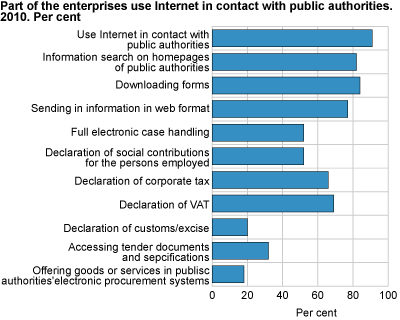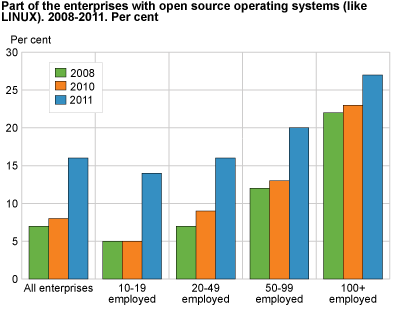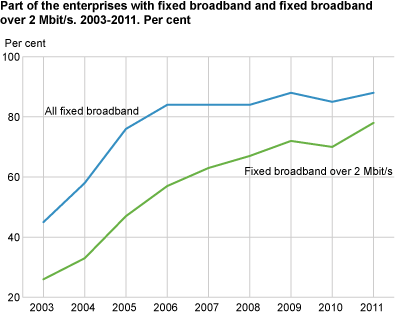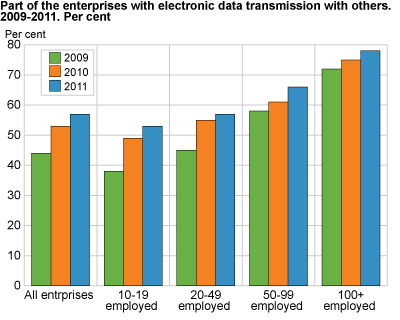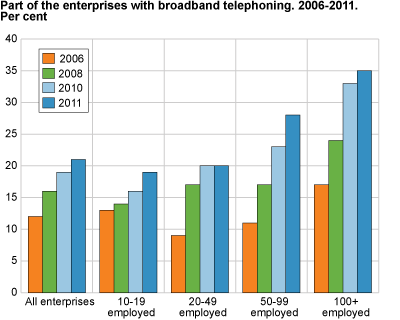Content
Published:
This is an archived release.
Public authorities’ websites are important for Norwegian enterprises
Nine out of ten enterprises used the Internet in their contact with public authorities in 2010. The main reason was to manage administrative procedures electronically, e.g. declaration of social contributions, corporate tax, VAT and customs/excise.
Public authorities’ websites or home pages are becoming more and more important for Norwegian enterprises. The share of enterprises that used the Internet in their contact with public authorities has increased from 80 per cent in 2009 to 91 per cent in 2010. Over four out of five obtained information from public authorities’ websites or home pages; an increase of 10 per cent compared to the last year. Eighty-four per cent of enterprises visited public authorities’ websites in order to obtain forms and 77 per cent of enterprises returned completed forms electronically in 2010. Furthermore, over half of all enterprises handled an administrative procedure completely electronically without the need for paper work, e.g. declaration, registration, authorisation request.
Half of all enterprises returned declarations of social contributions for employees electronically. Two out of three did this for declarations of corporate tax. Meanwhile, seven in ten enterprises used the Internet to return VAT declarations. In 2010, one out of three enterprises used the Internet to access tender documents and the specifications in electronic procurement systems of public authorities, while 18 per cent of enterprises offered goods or services through public authorities’ electronic procurement systems (eTendering).
Popularity in third party open source software use
Use of operating system(s) with a third party open source code, e.g. Linux, has increased from 8 per cent in 2010 to 16 per cent in 2011. Large enterprises seem to use such operating systems much more than small enterprises. The industry Information and communication uses Linux more than the others. In total, 37 per cent of enterprises in this sector used a Linux operating system in January 2011. About two in five enterprises used Internet browser software, e.g. Mozilla, Firefox or Chromium. Internet browser software with a third party open source code seems equally popular in small and large enterprises. Surprisingly, seven out of ten enterprises in the industry Information and communication used an open Internet browser in January 2011. One in three enterprises used office software with an open source code, e.g. OpenOffice. Small enterprises seem to use OpenOffice slightly more than large enterprises.
Use of mobile broadband increased rapidly
Ninety-seven per cent of enterprises with at least 10 persons employed had Internet access in January 2011 in Norway. Connection to the Internet via mobile broadband has increased rapidly during the last year. In total, 53 per cent of enterprises used mobile broadband connection at the beginning of 2011. Of this, 45 per cent used a mobile broadband connection via portable computer using modem with at least 3G technology; an increase of 8 percentage points compared to last year. Thirty-eight per cent of enterprises used handsets with at least 3G technology. The corresponding figure was only 18 per cent in January 2010. Large enterprises seem to have better access to mobile broadband than small enterprises. In addition, the industries Information and communication, Financial and insurance activities, and Wholesale trade used mobile broadband connections more often than the other industries.
In total, nine out of ten enterprises in January 2011 had access to all types of broadband connection. This has increased by 3 per cent compared to last year. Eighty-eight per cent had a DSL connection or other fixed Internet connection. The corresponding figure in 2010 was 85 per cent. Growth in transmission capacity continues according to the statistics. About four out of five have a fixed Internet connection with a transmission capacity over 2 Mbit/s; an increase of 8 per cent compared with last year. Meanwhile, the share of enterprises with a fixed connection with transmission capacity under 2 Mbit/s has decreased from 25 per cent in 2010 to 20 per sent in 2011. Furthermore, there were still 22 per cent of enterprises that had ISDN or a traditional modem in January 2011.
Four in five have a website or home page
The share of enterprises with a website or home page was 79 per cent, which was unchanged compared to last year’s figure. There was considerable diversity in the facilities of enterprises’ websites or home pages. Two out of five have product catalogues or price lists available on their websites or home pages. Three out of ten offer online ordering or reservation or booking, e.g. shopping cart.
Services that entail active interaction between the enterprise and the customer are not common. No more than 10 per cent of the enterprises had home pages with facilities for personal adaptation of the product and tracking of orders. Twelve per cent gave the customer a home page with individually adapted content (recognising the customer from previous visits). A total of 43 per cent of the enterprises used the home page for recruiting personnel, while 17 per cent issued a statement about the enterprise’s policy on privacy protection or a security certification. This indicates that large enterprises have generally more advanced websites or home pages than small enterprises, which means they offer more facilities.
Increased exchange of electronic data between enterprises
From 2010 to 2011, the share of enterprises that exchanged electronic data with others increased from 53 to 57 per cent. The enterprises with 10-19 persons employed increased from 49 to 53 per cent, while those with at least 100 persons employed increased from 75 to 78 per cent. The difference between large and small enterprises is still substantial.
One out of three enterprises have sent payment instructions to financial institutions electronically. This was an increase of 4 per cent compared to last year. The exchange of product information, e.g. catalogues and price lists, is becoming increasingly important between enterprises. The share of enterprises that has sent or received product information has increased from 22 per sent to 44 per cent in the last year. In addition, half of the enterprises exchanged data with public authorities in January 2011.
Fourteen per cent of the enterprises have sent electronic invoices in a standard structure suitable for automatic processing, e.g. EDI, UBL, XML. Meanwhile, two out of five sent electronic invoices that were not suitable for automatic processing, e.g. e-mails, e-mail attachments in PDF format.
Varied use of automatic share of information within the enterprises
Sharing information electronically and automatically between different functions within an enterprise varies considerably by enterprise size and by industry. Fifty per cent of enterprises share information from purchase or sales orders to the accounting function electronically and automatically. The difference between industries is relatively small. Thirty per cent of enterprises used such information in the management of inventory levels in January 2011.
Seven out of ten use e-commerce
Sixty-nine per cent of enterprises carried out e-commerce transactions in 2010; either the sale or purchase of goods or services conducted over computer networks.
In all, 36 per cent of enterprises made e-commerce sales in 2010. One out of three received orders for products or services placed via websites, while 7 per cent of enterprises made sales via EDI-type messages. EDI (Electronic Data Interchange) is used as a generic term for sending or receiving business information in an agreed format that enables automatic processing.
Three out of five enterprises made e-commerce purchases in 2010. Over half placed orders for products or services via websites. EDI-type messages were used by 14 per cent of enterprises in e-commerce purchases in 2010.
One out of five have broadband telephony
The share of enterprises using broadband telephony increased from 19 per cent in January 2010 to 21 per cent in the corresponding period in 2011.
|
Many other European countries produce statistics about ICT usage in enterprises in cooperation with the EU’s statistical office Eurostat. The plan for this survey is adapted to Eurostat guidelines. Internationally comparable figures can be found here: http://epp.eurostat.ec.europa.eu/portal/page/portal/information_society/introduction |
Tables:
- Table 1 Proportion of all enterprises that used third party open source software, by employment groups and area of industry. 2011. Per cent
- Table 2 Proportion of all enterprises with different types of Internet connections, by employment groups and area of industry. 2011. Per cent
- Table 3 Proportion of all enterprises with Website or Home Page, by employment groups and area of industry. 2011. Per cent
- Table 4 Proportion of all enterprises which used Internet in various ways for dealing with public authorities, by employment groups and area of industry. 2010. Per cent
- Table 5 Proportion of all enterprises which used Internet in various ways for dealing with public authorities, by employment groups and area of industry. 2010. Per cent
- Table 6 Proportion of all enterprises with different types of electronic transmission of data with others, by employment groups and area of industry. 2011. Per cent
- Table 7 Proportion of all enterprises med automatic share of information within the enterprise, by employment groups and area of industry. 2011. Per cent
- Table 8 Proportion of all enterprises with e-Commerce, by employment groups and area of industry. 2010. Per cent
Contact
-
Yun Walther-Zhang
E-mail: yun.walther-zhang@ssb.no
tel.: (+47) 40 90 25 38

